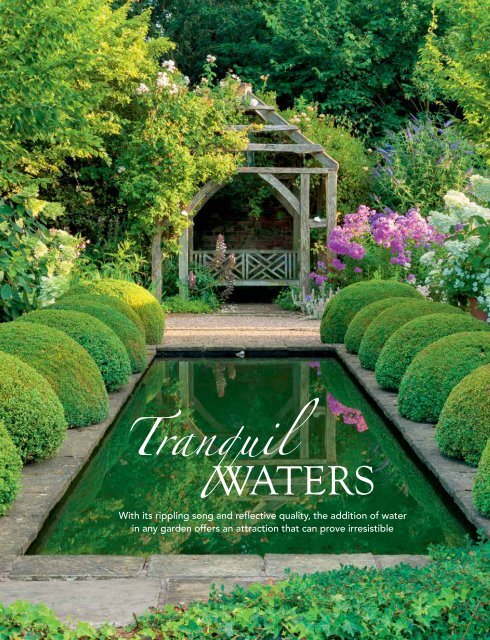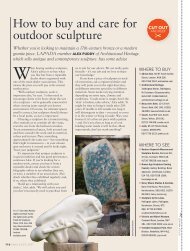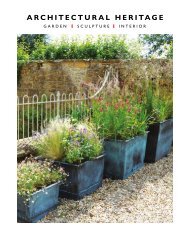The English Home water features
Create successful ePaper yourself
Turn your PDF publications into a flip-book with our unique Google optimized e-Paper software.
OPPOSITE PAGE <strong>The</strong> Rill Garden at Wollerton Old Hall<br />
Garden in Shropshire has two rows of Buxus sempervirens<br />
balls backed by Carpinus betulus ‘Frans Fontaine’.<br />
LEFT An elegant two tier fountain in age-patinated artificial<br />
stone with circular pool surround, based on an eighteenthcentury<br />
original. Two Tier Fountain, £7,680; decorative<br />
circular pool surround, £4,560, both Architectural Heritage<br />
ABOVE <strong>The</strong> Lily bowl by Urbis comes in several finishes,<br />
from hammered stone to rust (as shown above). £POA<br />
<strong>The</strong> garden design is by Carolyn Grohman and Watergems.<br />
Tranquil<br />
WATERS<br />
With its rippling song and reflective quality, the addition of <strong>water</strong><br />
in any garden offers an attraction that can prove irresistible<br />
T<br />
he introduction of a sophisticated<br />
<strong>water</strong> feature can enormously<br />
enhance the enjoyment of a<br />
beautiful <strong>English</strong> garden, not<br />
only because of its importance as a vital<br />
lifesource for wildlife, but also for its<br />
ever-changing therapeutic display. <strong>The</strong>re<br />
are several creative ways in which <strong>water</strong><br />
can be introduced into any size of garden<br />
or outdoor space and – with careful<br />
planning – it can be easily maintained.<br />
WATER AS ART<br />
A simple sculpture or bowl may be all<br />
that is required, and such structures offer<br />
versatility in size, from a simple bubble<br />
pool sited on a terrace to a grand sculpture<br />
taking centre stage on a majestic lawn.<br />
Artist David Harber’s first garden<br />
sculptures were based on sundials. His<br />
collection also now includes sculptural<br />
<strong>water</strong> <strong>features</strong>, inspired by the energy<br />
of <strong>water</strong> and its ability to create a certain<br />
magic and sense of calm. Harber’s pieces<br />
respond to their locations, reflecting<br />
foliage, creating places of quiet<br />
absorption and instilling awareness<br />
of their surroundings. <strong>The</strong> sculptural<br />
interplay complements the environment<br />
within which they stand. “Having made<br />
sundials and sculptural sundials for about<br />
a decade, the challenge of harnessing the<br />
element of <strong>water</strong>, to not only enhance<br />
a sculpture but to actually become the<br />
sculpture, became an exciting prospect and<br />
opportunity,” Harber says. “<strong>The</strong> constraints<br />
of fluid dynamics, gravity and many other<br />
technical issues were a very steep learning<br />
curve – <strong>water</strong> will do what it wants to do.<br />
It is the job of the designer to play with<br />
these constraints and physical laws to the<br />
best advantage. One of my early <strong>water</strong><br />
<strong>features</strong> – Chalice, which was my first<br />
marriage of sundial and <strong>water</strong> – is a simple<br />
hemispherical form with highly reflective<br />
surfaces, creating a seemingly implausible<br />
use of surface tension and momentum.”<br />
Peter Eustance – a garden designer with<br />
a background in biology and plant sciences<br />
– has a holistic approach that combines<br />
the natural and aesthetic qualities of<br />
<strong>water</strong> in a garden. He likes to create <strong>water</strong><br />
<strong>features</strong> that are simple and precise, yet<br />
extremely effective and suitable for most<br />
garden settings. Eustance is particularly<br />
keen on interactive elements, as could be<br />
seen at this year’s Chelsea Flower Show.<br />
His Together We Can garden included<br />
a <strong>water</strong> marimba to transform the garden<br />
into an acoustic landscape and was<br />
designed in collaboration with the<br />
world-famous solo percussionist<br />
Dame Evelyn Glennie on behalf of the<br />
disability organisation, Papworth Trust.<br />
Adding the element of <strong>water</strong> to a garden<br />
in sculptural form need not be complicated<br />
or expensive. <strong>The</strong>re are many <strong>water</strong> <strong>features</strong><br />
that do not take up a lot of space, are easy<br />
to install and will blend comfortably into<br />
an established garden. Lily Bowl by Urbis<br />
is one such example. Described as<br />
‘a pond in a pot’, it can be used either as<br />
a <strong>water</strong> bowl or a planter. It comes in a<br />
variety of stone or metal finishes, and with<br />
a diameter of just 118cm and a height of <br />
THE ENGLISH HOME 131
A <strong>water</strong> feature, however small,<br />
adds a soothing dimension to garden design<br />
TOP LEFT A traditional wall mask fountain.<br />
Grotesque Mask, £94, Haddonstone<br />
ABOVE RIGHT In this garden by<br />
Claudia de Yong a rill leads the eye to<br />
a wall fountain and a lead cistern planted<br />
with lotus flowers. For a similar cistern<br />
try Bulbeck Foundry.<br />
ABOVE An art deco-inspired vertical rill<br />
of verdigris bronze and mirror-polished<br />
stainless steel.<br />
Volante, £POA, David Harber<br />
45cm, it can be positioned on a deck or<br />
a terrace. Where space is limited, the cast<br />
stone Eclipse Fountain by Haddonstone<br />
is the perfect solution. Measuring 31cm<br />
across by 29cm high, it can be sited on<br />
a tabletop or next to a seating area for<br />
a touch of audio therapy. Its self-circulating<br />
fountain means it does not need a <strong>water</strong><br />
source, but it does have a pump so needs<br />
to be set close to an electricity supply.<br />
HISTORICALLY CORRECT<br />
Whilst many modern <strong>features</strong> sit well in<br />
the grounds of older properties, adding<br />
a contemporary contrast, sometimes the<br />
introduction of period artefacts is<br />
preferable. Alex Puddy of Architectural<br />
Heritage has a wealth of knowledge about<br />
antique and reproduction garden <strong>water</strong><br />
<strong>features</strong>. Chatting about the restoration of<br />
old marble and stone, Puddy’s enthusiasm<br />
is infectious as he describes helping<br />
clients and designers with projects, whether<br />
restoring existing <strong>features</strong> or adding new<br />
ones. In addition to having a selection<br />
of antiques on display, Architectural<br />
Heritage also offers several reproduction<br />
<strong>water</strong> <strong>features</strong> in age-patinated artificial<br />
stone. “We achieve the look by handfinishing<br />
and patinating to our own<br />
formula in a four-stage process,” he<br />
explains Puddy. “When completed, it<br />
produces a look akin to an old weathered<br />
garden ornament. This artificially aged<br />
stone is particularly suitable for <strong>water</strong><br />
<strong>features</strong> due to its strength and its<br />
resilience to extreme temperatures.”<br />
WILDLIFE HAVEN<br />
As well as being aesthetically pleasing,<br />
the addition of a <strong>water</strong> feature is beneficial<br />
to wildlife, attracting frogs, dragonflies<br />
and birds, to name but a few.<br />
It is advisable to employ a garden designer<br />
to offer essential, expert advice on<br />
establishing a pond and encouraging wildlife.<br />
As Chelsea Gold Medal winning garden<br />
designer Claudia de Yong says, “Having a<br />
<br />
THE ENGLISH HOME 133
LEFT This garden, designed by Joe Swift, has <strong>water</strong> falling<br />
into a pool from a contemporary-style rusted metal rill that<br />
is surrounded by architectural plants. TOP ‘Le Jardin Perdu’<br />
by Claudia de Yong contains a lily pond flanked by trees,<br />
stone arches and fallen masonry to provide a romantic feel.<br />
ABOVE Claudia de Yong designed this wildflower pond to<br />
fit into the natural landscape by using soft planting and<br />
placing a wooden pontoon at one end.<br />
SHOW GARDENS<br />
If inspiration is required before installing<br />
a <strong>water</strong> feature, some can be viewed<br />
in a garden setting.<br />
• David Harber has a semi-permanent<br />
exhibition in the private gardens<br />
of Eaton Square in London.<br />
Viewing by appointment only.<br />
• Peter Eustance’s work can be seen<br />
at <strong>The</strong> Symphonic Gardens Gallery,<br />
Grimsthorpe Castle, Lincolnshire.<br />
Viewings by appointment only.<br />
• Architectural Heritage is based in<br />
the grounds of Taddington Manor<br />
in Gloucestershire and has several<br />
examples of reproduction <strong>water</strong><br />
<strong>features</strong> on display.<br />
• <strong>The</strong> Swimming Pond Company<br />
has a show pool at its headquarters<br />
in Norfolk. Viewings by appointment.<br />
• Gartenart Swimming Ponds organises<br />
events throughout the year at<br />
established ponds that it has<br />
previously installed.<br />
<strong>water</strong> feature, however small, adds another<br />
dimension. Not only does it provide a calm<br />
relaxing atmosphere with reflective qualities<br />
and gentle movement, but it also attracts<br />
and provides a haven for wildlife.”<br />
De Yong also points out that there is<br />
a wonderful array of plants that can be<br />
introduced once a pond has been built.<br />
“Large hardy <strong>water</strong> lilies add impact. Good<br />
varieties include ‘Pink Sensation’ and ‘Joey<br />
Tomocik’. <strong>The</strong>re are also miniature hardy<br />
lilies such as Pygmaea alba.”<br />
Species to plant at the edge of a pond<br />
include Butomous umbellatus, which has<br />
clusters of pink flowers; Scirpus zebrinus,<br />
the green and white zebra rush; Pontederia<br />
cordata, which has striking blue flowers<br />
and thick green leaves, and blue Myosotis<br />
palustris, a <strong>water</strong> forget-me-not.<br />
CONTEMPLATIVE RILLS<br />
Of all the <strong>water</strong> <strong>features</strong> used in gardens,<br />
the rill perhaps has the most interesting<br />
history. <strong>The</strong> earliest style of rill was found<br />
in ancient Persian gardens, but perhaps<br />
the most famous rills are in the gardens<br />
of the Moorish Alhambra Palace in<br />
Granada, Spain. <strong>The</strong> rill was a familiar<br />
<strong>water</strong> feature in many Gertrude Jekylldesigned<br />
Arts and Crafts gardens.<br />
<strong>The</strong> perfect choice for any size garden,<br />
a rill takes up little space and is easy to<br />
maintain, and can be used as a design<br />
feature to lead the eye to another part<br />
of the garden or as a functional feature<br />
to move <strong>water</strong> from one part of the garden<br />
to another. It can also be designed to have<br />
still, contemplative <strong>water</strong> or a stream of<br />
movement – the famous serpentine rill<br />
at Rousham House in Oxfordshire, built<br />
by garden designer William Kent in 1738,<br />
snakes through woods at ground level,<br />
transporting <strong>water</strong> through the gardens<br />
into an octagonal pool.<br />
Even the smallest of gardens can enjoy<br />
the delight of sunlight sparkling off a rill.<br />
A vertical rill falling into a small pond<br />
can be ideal in a small town garden and<br />
has the added benefit of masking any<br />
undesired ambient noise.<br />
<br />
THE ENGLISH HOME 135
LEFT This swimming pond by Gartenart<br />
makes an ideal place to sit and while away<br />
the hours or to enjoy a refreshing dip on<br />
a hot summer’s day.<br />
BELOW In this design by <strong>The</strong> Swimming Pond<br />
Company, a jetty has been positioned at the<br />
deeper end of the pond to bridge the aquatic<br />
planting of the regeneration zone and for the<br />
more adventurous to dive in from.<br />
<strong>The</strong> shallow depth of a rill makes it the<br />
perfect home for a range of marginal <strong>water</strong><br />
plants. Architectural plants, such as zebra<br />
rush, soft rush and yellow iris, look most<br />
effective in the formal structure of a rill.<br />
SWIMMING PONDS<br />
A pond need not be solely for the benefit<br />
of wildlife – if space and budget allow,<br />
it can also be for swimming. Although<br />
a relatively new phenomenon in the UK,<br />
swimming ponds are becoming increasingly<br />
popular. Landscape and garden designer<br />
Paul Mercer set up <strong>The</strong> Swimming Pond<br />
Company to combine his love of wild<br />
swimming with his passion for garden<br />
design. “Swimming ponds add interest<br />
all year round and still have a magical<br />
appearance at night or in winter,” he says.<br />
Mercer explains that swimming ponds<br />
differ from swimming pools in that no<br />
chemicals are used; <strong>water</strong> purification<br />
is achieved through biological filters<br />
used in conjunction with an electric<br />
pumping system. <strong>The</strong> pond is divided<br />
into two distinct and separate areas, with<br />
a swimming zone and a regeneration zone.<br />
It is advisable to employ a specialist<br />
company to install a swimming pond and<br />
help to establish an ecologically balanced<br />
environment in the pond, using plants<br />
and micro-organisms, to create a biological<br />
filter to attain clean, clear <strong>water</strong>.<br />
<strong>The</strong>re is one question that seems to<br />
dominate when people enquire about<br />
swimming ponds: Will the <strong>water</strong> be warm<br />
enough? Both Mercer and Tim Evans,<br />
of Gartenart Swimming Ponds, explain that<br />
swimming pond <strong>water</strong> temperatures in<br />
summer easily reach at least 20°C,<br />
sometimes even higher. This is due to the<br />
shallow <strong>water</strong> around the regeneration zone<br />
heating up naturally and filtering through<br />
the cooler <strong>water</strong> of the swimming zone.<br />
LOW MAINTENANCE<br />
Most <strong>water</strong> <strong>features</strong>, correctly installed,<br />
are designed for minimum maintenance,<br />
requiring no more time than tending<br />
a border filled with flowers and shrubs.<br />
“A small amount of care and attention is<br />
needed at times throughout the year, but<br />
it should not put anyone off having <strong>water</strong><br />
in their garden and all the enjoyment<br />
it will bring,” Claudia de Yong says.<br />
When you consider the broad selection<br />
of <strong>water</strong> <strong>features</strong> on offer, can a garden<br />
truly be complete without the addition<br />
of an ever-changing reflective surface and<br />
the gentle ripple of a <strong>water</strong>y cascade? n<br />
PRACTICAL CONSIDERATIONS<br />
• <strong>The</strong> structure should always<br />
relate to its surroundings in<br />
scale and materials.<br />
• If connection to the <strong>water</strong> supply<br />
is needed, excavation and plumbing<br />
work will be required.<br />
• <strong>The</strong> flow of <strong>water</strong> will be dependent<br />
on an accurate pump specification.<br />
• <strong>The</strong> sound produced will be dictated<br />
by the flow of <strong>water</strong>; whether a light<br />
trickle or a heartier fall is desired.<br />
• It is advisable to have pumps installed<br />
by a qualified electrician as these<br />
must meet safety regulations.<br />
• To avoid frost damage to fountains,<br />
<strong>water</strong> should be drained off before<br />
winter every year and not replaced<br />
until any risk of hard frost has passed.<br />
• A pond without a filtration system will<br />
need to be cleaned every few years.<br />
• All ponds need to be kept clean of<br />
falling leaves, whilst larger ponds may<br />
require professional maintenance.<br />
• If including lighting, it is important to<br />
conceal the fitting and allowing only<br />
the effect be visible.<br />
FEATURE JULIE HAWKER PHOTOGRAPHS P132 © JOE WAINWRIGHT/ALAMY; P135 (DAVID HARBER SCULPTURE) © CLIVE NICHOLS;<br />
P137 (RILL) © JO WHITWORTH/ALAMY<br />
136 THE ENGLISH HOME











